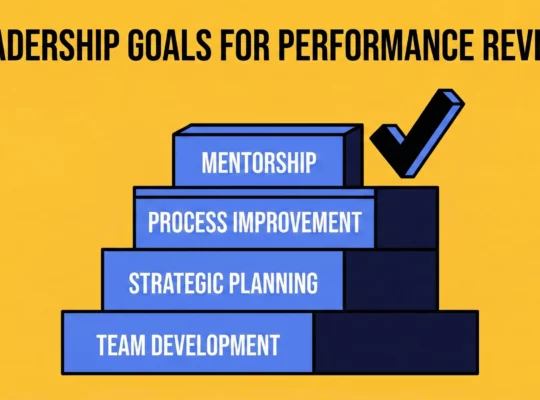Takeaways:
- An internal communications strategy aligns employees with business goals, improving engagement and transparency.
- Tailoring your communication to your audience’s needs ensures clarity and effectiveness.
- Regularly measure and adjust your communication efforts to maintain relevance and impact.
Effective communication within an organization is more than just sending emails or holding meetings. It’s about creating a clear internal communications strategy that aligns with business goals, engages employees, and fosters a two-way dialogue. At Review.jobs, we know how critical this is to ensure that every team member understands their role and is committed to the company’s success.
A well-structured internal communication plan helps your organization manage change, boost employee satisfaction, and keep everyone on the same page. In this article, we’ll explore the importance of a strategic internal communication plan and provide a step-by-step guide to creating one for your organization.
Table of Contents:
What is an Internal Communication Strategy?
An internal communications strategy is a structured plan that ensures clear and consistent communication within an organization. Its purpose is to align employees with the company’s goals, enhance collaboration, and foster a two-way dialogue between leadership and employees.
Top-down communication, which involves leadership sharing information with employees, is essential. But equally important is bottom-up communication, allowing employees to provide feedback and share ideas. An effective strategy helps bridge gaps between these communication types, creating a well-informed and engaged workforce.
Why is an Internal Communication Strategy Important?
A well-executed internal communication strategy delivers multiple benefits that impact both the organization and its employees:
- Boosts Employee Engagement: Clear communication fosters higher levels of employee engagement, making them more motivated and productive.
- Improves Goal Alignment: Employees can better align their actions with the company’s business goals, ensuring everyone is working towards a common purpose.
- Reduces Miscommunication: It minimizes misunderstandings and ensures that messages are clear and concise, saving time and avoiding errors.
- Enhances Collaboration: By encouraging cross-team interactions, internal communication helps break down silos and improves teamwork.
- Supports Change Management: Effective change management communication helps employees adapt to new processes, systems, or cultural shifts.
- Increases Trust and Transparency: Frequent and honest communication builds trust between leadership and employees, promoting organizational transparency.
- Promotes Employee Satisfaction: Recognizing and rewarding achievements through internal communication channels increases morale and boosts employee satisfaction.
Key Components of an Internal Communication Strategy
Building a strong internal communications strategy requires several key elements:
Business Goals and Objectives
Aligning internal communication with the company’s overarching business goals ensures that all employees are on the same page and working towards shared objectives.
Audience Segmentation in Communication
Identify different employee groups based on roles, locations, and needs. Effective audience segmentation ensures that messages are tailored to the right people at the right time.
Key Messages
Your messages should be clear, concise, and relevant to the audience. It’s important to use straightforward language that everyone can understand.
Communication Channels
Choosing the right internal messaging tools—like intranet platforms, email, and collaboration tools—is crucial for reaching every employee. For remote or deskless workers, mobile-friendly communication methods may be more effective.
Communication Cadence
Setting a regular communication cadence (e.g., weekly newsletters, and monthly town halls) helps maintain consistency without overwhelming employees.
Feedback Mechanisms
Creating channels for employee feedback is essential for fostering two-way communication. Tools like surveys or suggestion boxes allow employees to voice their opinions.
Metrics for Success
Track communication effectiveness metrics such as email open rates, employee engagement levels, and participation in feedback programs to measure success.
Steps to Build an Effective Internal Communication Plan
Step 1: Assess the Current Situation
Start by conducting an audit of your organization’s current communication practices. Use employee surveys, focus groups, and feedback channels to identify gaps in your existing strategy.
Step 2: Set Clear Communication Goals and Objectives
Use the SMART framework to set goals that are Specific, Measurable, Achievable, Relevant, and Time-bound. These goals should directly support your business goals.
Step 3: Segment the Audience
Tailor your communication strategy by identifying the different groups within your organization. Segmentation helps ensure that messages are relevant to the needs of each team, whether they are remote workers, deskless staff, or leadership.
Step 4: Develop Core Messages
Create key messages that align with the company’s objectives. Use the 5Ws and 1H framework (Who, What, When, Where, Why, and How) to structure your messages.
Step 5: Choose the Right Communication Channels
Select intranet platforms, email, and other internal collaboration tools that best suit your workforce. Consider using mobile apps for remote workforce communication.
Step 6: Set a Cadence for Communication
Determine a consistent schedule to avoid overcommunication. Ensure that the timing aligns with key business events and employee milestones.
Step 7: Train Managers as Communication Ambassadors
Managers play a critical role in reinforcing messages. Equip them with the tools and knowledge to act as effective communicators within their teams.
Step 8: Encourage Two-Way Communication
Establish feedback channels that encourage employees to share ideas and concerns. Make sure employees know their input is valued.
Step 9: Provide Consistent Recognition and Rewards
Publicly recognize employee achievements to boost morale. Use internal communication to highlight employee success stories and milestones.
Step 10: Monitor and Measure Progress
Use data to track the effectiveness of your internal communication strategy. Regularly review employee engagement levels, participation rates, and feedback to adjust your approach as needed.
Best Practices for Internal Communication Strategy
- Personalize Messages: Tailor messages to specific employee roles for maximum relevance.
- Use Multiple Channels: Leverage different tools like intranets, emails, and social platforms to ensure wide reach.
- Be Transparent: Share company goals openly to build trust and foster leadership communication.
- Encourage Informal Communication: Allow space for casual conversations that promote team engagement.
- Leverage Technology: Utilize digital workplace communication tools like wikis or collaboration apps to streamline processes.
- Recognize Employees: Use communication platforms to highlight employees’ hard work and contributions.
Challenges of Internal Communication
While internal communication offers numerous benefits, there are challenges to be aware of:
- Overcommunication or Information Overload: Too much information at once can overwhelm employees, leading to disengagement.
- Resistance to Change: Employees may be hesitant to adopt new tools or processes without proper explanation and training.
- Engaging Remote and Deskless Workers: These groups can be difficult to reach, requiring mobile-friendly or alternative communication tools.
FAQ:
What is an example of an internal communication strategy?
An example is a company using intranet platforms, newsletters, and surveys to share updates and gather feedback from employees.
What is strategic internal communication?
Strategic internal communication involves aligning messaging with business goals to engage employees and foster collaboration.
What does an internal communications strategist do?
They develop and implement plans that ensure effective communication within an organization, promoting engagement and clarity.
How do you strategize internal communication?
By assessing current practices, setting clear goals, segmenting the audience, and choosing appropriate communication channels, you can build a strong internal communication plan.
At Review.jobs, we believe an effective internal communication strategy is key to driving organizational success and employee engagement.





